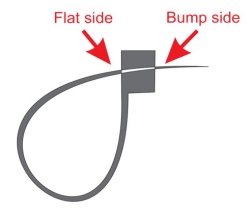6. Check each module to ensure the parts are
properly joined and the ties are tight. You can snip off
the tails with the wire cutter as a mark of which modules you
have checked.
7. The class now needs to work together to assemble the
modules. One way to begin is to pick five groups for the
first stage and ask one person from each group to bring their
module to the front of the room. Ask them to position them
to make a 5-fold star, as shown above. They will now be
joining the short segments. Suggest that they use symmetry
as a guide for how the parts join, along with the principle that
their beveled surfaces should mate together. They should
see that there are ten places they can now add a cable tie to
connect these modules. (Five are near the center of the
image above and five are on the sides.) While the first
five people continue to hold the parts, ask for a second person
from each group to come up and make two of the cable tie
connections. Hand out ten ties for this.

8. After this, the students should see the pattern and be able
to complete the structure, making similar 5-fold stars
everywhere. Tell them that they should make only 5-way
stars, never 4-way or 6-way. A general tip is that one student
can hold a piece in position where it is to be attached while
another student connects the cable ties. Depending on the
group, you can work in a very structured way, organizing them to
add five modules at a time symmetrically, or you can let them
explore and decide for themselves where and in what order to add
their modules. It is safest to keep adding modules to a
single growing structure. (It would not work to try making
two separate "halves" and hope they fit together!)
Encourage each group to have a turn then make room for
others. Allow them to answer each other's questions about
where to connect everything. Students will see the
patterns and figure out how to extend them to complete the
sculpture. Those who are waiting can take three more parts
and make another module until all twenty modules have been
built.

9. When complete, check all the connections are correct, all the
cable ties are tight, and snip off the ends of the ties.
10. While working, you can ask students who aren't engaged in
the construction to figure out how many cable ties are needed
all together. From the fact that there are 60 pieces and
each touches four others, they should determine there are 120
cable ties. That's 60·4 = 240 connection locations, but
divided by two because each tie joins two connection locations.
11. Take group photos and hang it up
on display. This image shows a version stained all in
one color.
12. And here's a version that is stained brown on the
outside and yellow on the inside, assembled at a workshop at
Eastern Carolina University.

















